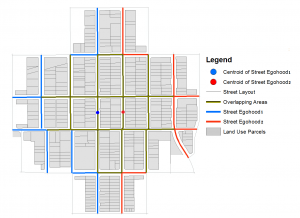Defining “neighborhoods” is challenging for researchers. In prior research lab members Dr. Hipp and Dr. Adam Boessen proposed a novel measure, termed “egohoods”, that captures the area surrounding a particular block (based on straight-line distance). This new study extends this idea by explicitly incorporating the street network into the measure. This approach measures street egohoods based on the local street block, and then all adjacent streets. A second definition includes all street blocks one or two streets away from the focal block. We believe that these are plausible “neighborhoods” since residents can easily come into contact one or two street blocks away from their own street block. The approach is demonstrated using data for the Southern California region, we find that this measure of immigrant neighborhoods often exhibits a robust negative relationship with levels of crime.
You can access the article by Dr. Young-an Kim and Dr. John R. Hipp in the Journal of Quantitative Criminology entitled, “Street Egohood: A New Perspective of Measuring Neighborhood Based on Urban Streets.”
Get it here: https://link.springer.com/article/10.1007/s10940-019-09410-3
Abstract:
“Objectives: The current study proposes an approach that accounts for the importance of streets while at the same time accounting for the overlapping spatial nature of social and physical environments captured by the egohood approach. Our approach utilizes overlapping clusters of streets based on the street network distance, which we term street egohoods.
Methods: We used the street segment as a base unit and employed two strategies in clustering the street segments: (1) based on the First Order Queen Contiguity; and (2) based on the street network distance considering physical barriers. We utilized our approaches for measuring ecological factors and estimated crime rates in the Los Angeles metropolitan area.
Results: We found that whereas certain socio-demographics, land use, and business employee measures show stronger relationships with crime when measured at the smaller street based unit, a number of them actually exhibited stronger relationships when measured using our larger street egohoods. We compared the results for our three-sized street egohoods to street segments and two sizes of block egohoods proposed by Hipp and Boessen (Criminology 51(2):287–327, 2013) and found that two egohood strategies essentially are not different at the quarter mile egohood level but this similarity appears lower when looking at the half mile egohood level. Also, the street egohood models are a better fit for predicting violent and property crime compared to the block egohood models.
Conclusions: A primary contribution of the current study is to develop and propose a new perspective of measuring neighborhood based on urban streets. We empirically demonstrated that whereas certain socio-demographic measures show the strongest relationship with crime when measured at the micro geographic unit of street segments, a number of them actually exhibited the strongest relationship when measured using our larger street egohoods. We hope future research can use egohoods to expand understanding of neighborhoods and crime.”
Figure of street egohoods based on adjacent streets
Figure of street egohoods based on 1/4 mile

